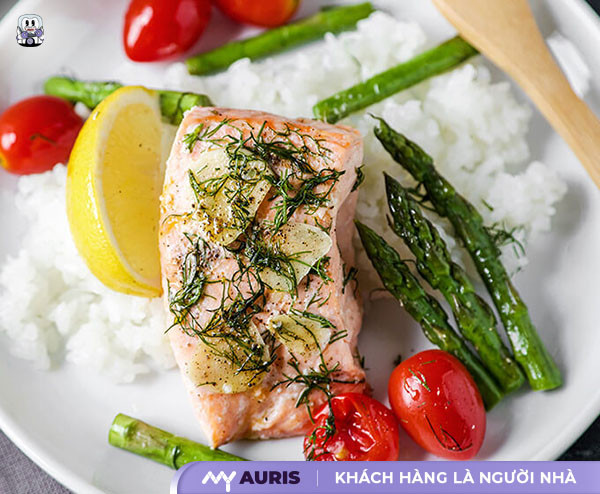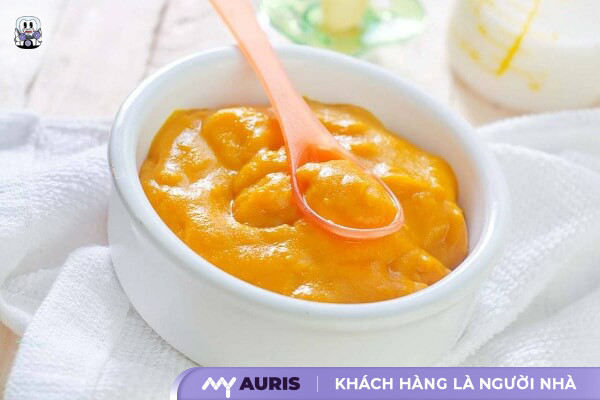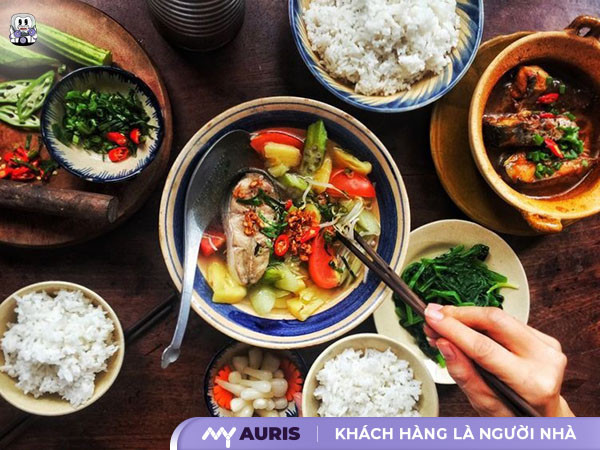Have you just started your braces journey? Feeling pain and discomfort when chewing is inevitable. A reasonable diet will help you overcome this difficult period, while ensuring that the orthodontic process goes smoothly and quickly. This article will share the “golden” foods that help you take the best care of your teeth throughout the braces process, from the early stages until you can eat comfortably again.
Golden rules when eating for newbies braces
The top three criteria when choosing food in the early stages of braces (what should you eat if you’re new to braces?):
Soft: Food must be soft enough to avoid causing pain, not damaging teeth, gums and gums. install. This is the most important factor in the early stages, especially during the adaptation period (time). Prioritize pureed foods, mashed foods, soups, smoothies. Rice needs to be cooked thoroughly and soft.
Nutrition: Although priority is given to soft foods, the diet must still ensure adequate nutrients necessary for the body, supporting the braces process to proceed smoothly. Combine a variety of foods to provide enough protein, carbohydrates, fiber and vitamins. Liquid foods, mashed foods, soups, smoothies or soft foods all need to be fully supplemented with nutrients.
Easy to clean: Oral hygiene with braces becomes more important than ever. Choosing foods that have little adhesion to braces helps you easily clean your teeth and prevent cavities and gingivitis. Limit foods that easily get stuck between braces such as nuts, chewy foods that are difficult to chew.
In the early stages of braces (first stage of braces), you need to pay special attention to the softness of food. Recovery time and pain will vary for each person, but will usually decrease after a few weeks:
Weeks 1-2: Prioritize liquid foods such as soup, smoothies, porridge. Rice needs to be cooked thoroughly, and can even be pureed.
Weeks 3-4: Start adding soft foods such as mashed pumpkin, crushed rice, and pureed meat. Don’t forget to check the softness of the rice by gently pressing with a fork: if the rice grain doesn’t keep its shape, it’s soft enough to eat.
After 1 month: If there is no more pain, you can slowly eat rice normally, but you should still limit hard foods that are difficult to chew. The menu after braces needs to be maintained properly to ensure oral health.

“Golden” foods for people new to braces
Protein group
Protein plays an important role in building and repairing tissues, and is especially necessary during orthodontics. To provide enough protein while still ensuring softness and ease of chewing, you should choose:
Softly processed chicken, pork, and beef:
- Pate: Put the pureed meat with onions, chopped carrots, and spices (salt, pepper, seasoning) into a blender. Blend until mixture is smooth. Put the mixture in a steamer for about 30 minutes or put it in a small pan, simmer for about 20-25 minutes, stirring well. Pate is an easy-to-digest food after braces and is very nutritious.
- Bolognese sauce: Saute chopped onion with olive oil. Add minced meat, stir-fry until cooked. Add tomato puree, broth, and spices, simmer until sauce thickens. Bolognese sauce can be used with short-cut udon noodles or crushed rice, creating a nutritious dish for orthodontists.
Steamed salmon:
Salmon is rich in Omega-3, which reduces gingivitis and supports the healing process in the mouth. Steam salmon until soft and easy to chew and swallow. This is one of the ideal dishes on the menu after braces. Steaming time depends on the thickness of the fish pieces, usually about 15-20 minutes is enough. You should choose fresh, not spoiled salmon to ensure the quality of the dish. This is also a great choice for easily digestible foods after braces.

Vegetable group
Vegetables provide essential vitamins and minerals, supporting health maxillofacial teeth. However, you need to choose one that is soft and easy to chew:
Pumpkin mash:
Boil the pumpkin until soft. Use a spoon to puree the pumpkin, adding a little unsweetened fresh milk to create a smooth consistency. Mashed pumpkin adds vitamin A and essential fiber. You can add a little unsweetened yogurt to increase the appeal.
Smoothie spinach and banana:
Put spinach, banana, fresh milk (or nut milk) into the blender. Grind until smoothn until the mixture is smooth. Smoothie provides plenty of fiber, vitamins and minerals necessary for oral health. You can adjust the ratio of spinach and banana to your preference to get the right flavor.

Smart Carbs
Starch provides energy, but you need to choose a soft, easy-to-digest type:
Cheese oatmeal:
Cook oatmeal according to the instructions on the package. When the porridge is cooked, add shredded cheese and stir well. This dish provides protein, calcium and fiber. You can add a little honey to increase the sweetness if you like.
Crushed rice with meat sauce:
Cook the rice until soft, use a spoon to mash it. Combine with meat sauce (like the Bolognese sauce instructed above) to create a nutritious dish. To achieve the ideal softness of rice, you should wash the rice thoroughly and soak the rice before cooking for about 30 minutes. Adding a little more water than usual when cooking will help make the rice softer.
7-day non-repeatable menu for people new to braces
This menu is designed specifically for people new to braces, especially in the early stages when pain and difficulty in chewing are still high. Here is an eating guide for people with braces, to help you quickly adapt to the new diet:
Day 1: Focus on liquid foods and pureed foods.
- Breakfast: Oatmeal porridge cooked with unsweetened fresh milk, add a little soft cheese.
- Lunch: Smooth pumpkin soup, combined with a few pieces of soft steamed salmon. Salmon is rich in Omega-3 which helps reduce gingivitis, a common problem when new braces are applied.
- Dinner: Banana, spinach smoothie and unsweetened yogurt. The formula is simple but provides all the necessary vitamins and minerals.
Day 2: Add easy-to-chew foods.
- Breakfast: Unsweetened Greek yogurt with a few soft banana slices.
- Lunch: Cooked crushed rice (softness instructions will be provided later), served with pureed chicken into pate.
- Dinner: Cansh pumpkin with soft tofu, limit hard vegetables.
Day 3: Gradually increase the firmness of the food (but still soft).
- Breakfast: Tear soft bread, dipped in warm milk.
- Lunch: Short cut udon noodles, served with soft tofu with egg sauce.
- Dinner: Salmon porridge with pureed vegetables.
Day 4: Continue to diversify soft foods.
- Breakfast: Puree chicken soup, add chopped spaghetti.
- Lunch: Mashed pumpkin mixed with yogurt.
- Dinner: Mango smoothie, yogurt, and some oatmeal.
Day 5: Add additional options.
- Breakfast: Cooked oats with almond milk.
- Lunch: Rice, minced meat in tomato sauce (bolognese).
- Dinner: Vegetable soup with lean pureed meat.
Day 6: Focus on overall nutrition.
- Breakfast: Soft steamed eggs, served with soft toast.
- Lunch: Crushed rice, steamed salmon, pureed green vegetables.
- Dinner: Green bean soup with lean pureed meat.
Day 7: Keep balance.
- Breakfast: Fruit smoothie (banana, apple, strawberry).
- Lunch: Soft spaghetti, tomato sauce, pureed meat.
- Dinner: White porridge, soft boiled chicken, pureed vegetables.
How long after braces can I eat rice?
Week 1-2: In the first days after braces, the feeling of pain and discomfort is unavoidable. The body needs time to adapt to change. During the first week, soft, liquid foods are the optimal choice. Say goodbye to hard, hard-to-chew foods. The menu should include porridge, soup, smoothies, pureed foods, and various soups. The main goal is to minimize pain and allow your mouth to get used to the braces.
Weeks 3-4: After about two weeks, you can start tryingseason with rice. However, the rice needs to be moist and soft. Visualize the grain of rice almost dissolving when you gently press it with a fork. If the rice grains keep their shape, it means the rice is still too hard and not suitable. You should still limit foods that are hard and difficult to chew.
After a month: If you no longer feel significant pain or discomfort, after a month you can start eating rice normally. However, you should still limit foods that are too hard and difficult to chew for a long time.

Eating mistakes that slow down the braces process
Eating foods that are too hard and difficult to chew causes damage to teeth and braces
In the early stages of braces, your teeth are very sensitive. Eating too hard foods such as tough meat, bones, crispy bread, hard candy… will cause pain, loosen or even break the braces. This not only causes discomfort but also prolongs treatment time and slows down the braces process.
Chewing on one side causes bite misalignment and affects the results of braces
Many people have the habit of chewing on one side, especially when they first get braces and feel pain. However, this causes an imbalance in chewing force, leading to bite misalignment, affecting the long-term results of braces. To avoid this, try to chew evenly on both sides of the jaw.
Abusing smoothies that lack crude fiber, affecting digestion
Smoothies are a convenient choice for people new to braces because they are easy to drink and digest. However, overusing smoothies and ignoring other foods rich in crude fiber will lead to fiber deficiency, causing indigestion and constipation.
Eating food that is too hot or too cold causes numbness in the teeth
Food temperature also affects the oral sensation of people with braces. Eating food that is too hot or too cold will cause toothache, discomfort, and even damage to the gums. Eat food at the ideal temperature to protect your teeth and gums.
Not cleaning your teeth thoroughly can easily cause gingivitis
Braces are an ideal environment for bacteria to grow. Therefore, thorough oral hygiene is more necessary than ever. Brush your teeth properly and use dental flossa, medical mouthwashes are important measures to help prevent gingivitis, tooth decay and other oral diseases.
Frequently Asked Questions About Diet When Braces
Can you eat instant noodles with braces?
Many people like to eat instant noodles because of convenience. However, instant noodles are hard food, difficult to chew and can easily cause damage to teeth when you first get braces. Eating instant noodles when you first have braces can cause pain and even loosen or pop the braces. So what is the solution?
You can absolutely eat instant noodles, but you need to note the following:
Soak the noodles thoroughly: The noodles must be soft, almost dissolving in water. Check by gently pressing with a fork. If the noodles cannot keep their original shape, they are soft enough.
Cut noodles: Cut noodles into short, small, easy-to-swallow pieces to minimize chewing force.
Limit hot spices: Spices Hot spicy food can irritate the gums and increase discomfort.
Eat slowly, chew thoroughly: Even though noodles are soft, they still need to be chewed thoroughly to avoid causing problems with braces.
Is it necessary to abstain completely? all grilled foods?
Barbecued foods, especially the crunchy, hard parts, are difficult to chew and can damage braces. However, this doesn’t mean you have to completely abstain from baked goods. You can still enjoy grilled food but you need to keep in mind the following points:
Choose soft parts: Choose soft, easy-to-chew meat parts. Avoid brittle skin and hard bones.
Cut food into small pieces: Cut meat into bite-sized pieces to reduce chewing force.
Chew thoroughly: Chew slowly and thoroughly to avoid damaging braces.
Limit grilled foods in the beginning: During the first period of braces, when your teeth are still sensitive, limit eating grilled foods to avoid causing pain and damage.
A harmless way to eat bread install?
Bread is a familiar dish, but it is a challenge for people new to braces. Hard bread crusts can easily break or loosen braces. To enjoy bread without harming your teeth, follow these steps:
Tear the bread: Tear the bread into small, soft pieces.
Dip the bread in warm milk: Dip the bread in warm milk to soften it. noodles.
Chew thoroughly: Chew thoroughly to reduce chewing force on teeth and braces.
Limit eating hard bread: In the early stages of braces, you should limit eating bread, especially bread with a hard crust.
If you have difficulty choosing food or have any questions, please contact My Auris Dentistry. Team of experts Our staff will advise on a suitable diet, ensure oral health and an effective braces process. We are committed to providing the best service, helping you be confident with a radiant smile. Make an appointment today.





